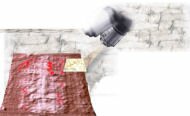
SHROUD SCIENCE GROUP INTERNATIONAL CONFERENCE
The Shroud of Turin: Perspectives on a Multifaceted Enigma
OHIO STATE UNIVERSITY BLACKWELL HOTEL
August 14 through August 17, 2008 Abstracts of Papers
Was Sixth-century Desertification a Factor in the Transfer of Relics from Palestine? by Diana Fulbright (sindon@ globalweb.net). Saturday, August 16, 4:45 p.m.–5:10 p.m.
This paper examines the possible connection of a sixth-century climate change in Jerusalem and the Dead Sea area, with severe societal impact, to removal of relics -- specifically the Sudarium of Oviedo and the Shroud of Turin -- from the region around that time.
Numerous paleoclimatic studies involving geology, hydrology, palynology, seismology, meteorology, archaeological remains and historical evidence indicate that the Dead Sea region, verdant from about the first century B.C., became desert rather abruptly in the sixth century.
The mid-sixth century is important in establishing the provenance of the Shroud. Iconography possibly reflecting the facial image on the Shroud is indisputably dated to that time -- in particular the Emessa Vase, now in Musée de Louvre, Paris, and the encaustic Pantocrator of the Monastery of Saint Catherine at Mount Sinai. In the late sixth century, reference to the “Image of Edessa” (adduced as the same cloth now known as the Turin Shroud) appeared in the historical record. The Sudarium is said to have been removed from Jerusalem in the early seventh century. Thus, the drastic environmental changes of the sixth century, with resulting social dislocation, may support the posited timelines of transfers of the Shroud and the Sudarium from Palestine.
In view of the extremely arid climate of the Dead Sea region in modern times, one may wonder if this could really have been a thriving agricultural area 2,000 years ago. In fact, archaeological and palynogical evidence confirms that it was. It has been observed that in marginal desert areas, even minor climatic changes can result in dramatic environmental changes.
Content Hosted by Innoval Systems Solutions, Inc & Shroud Story